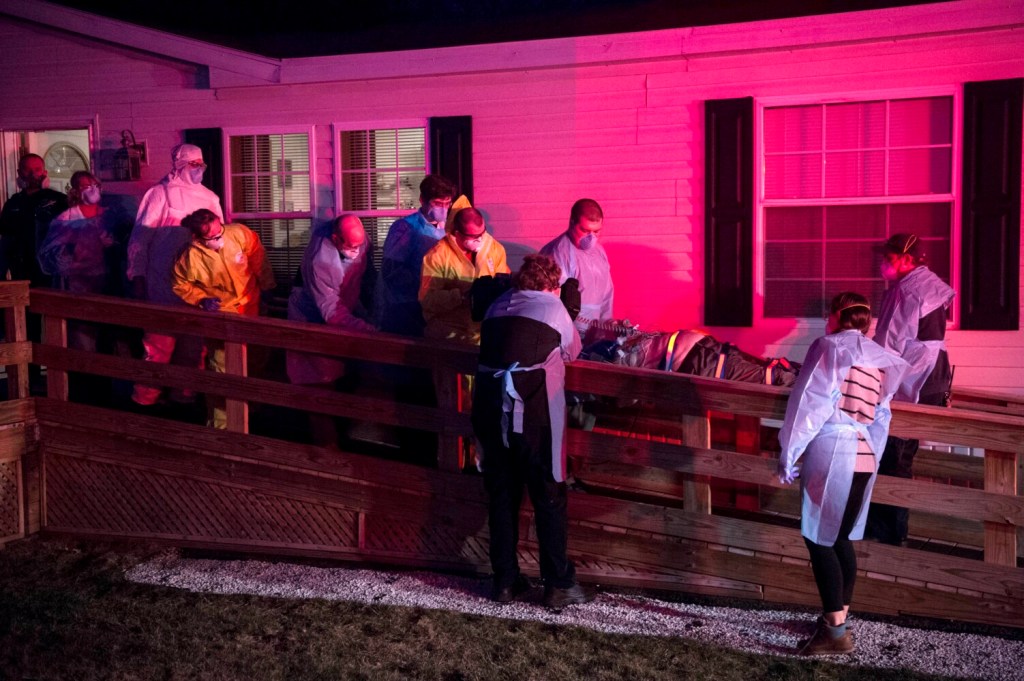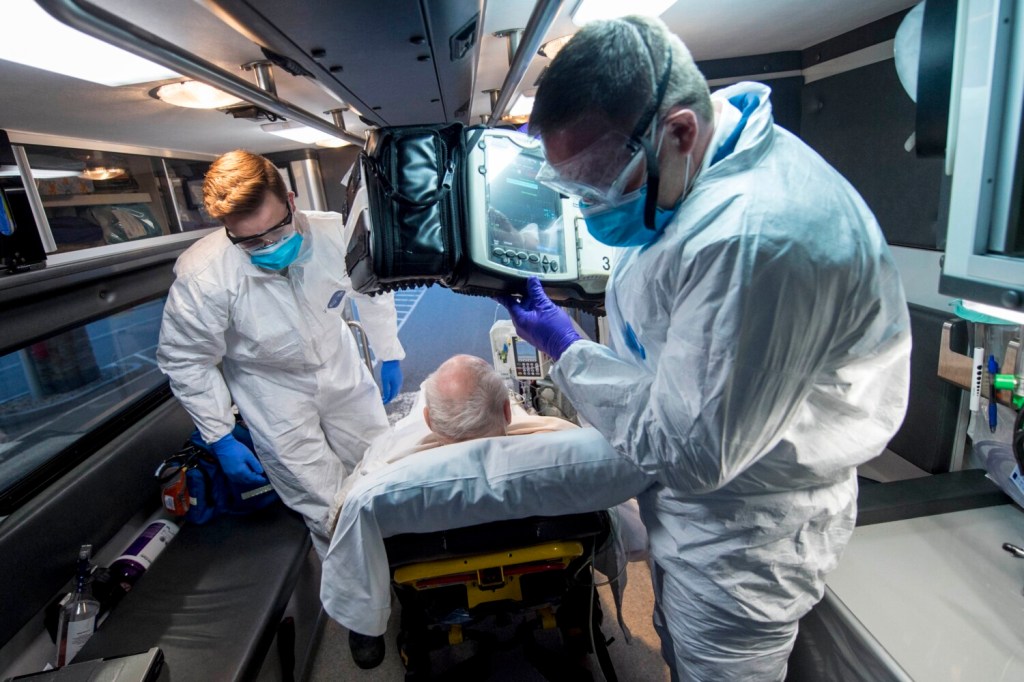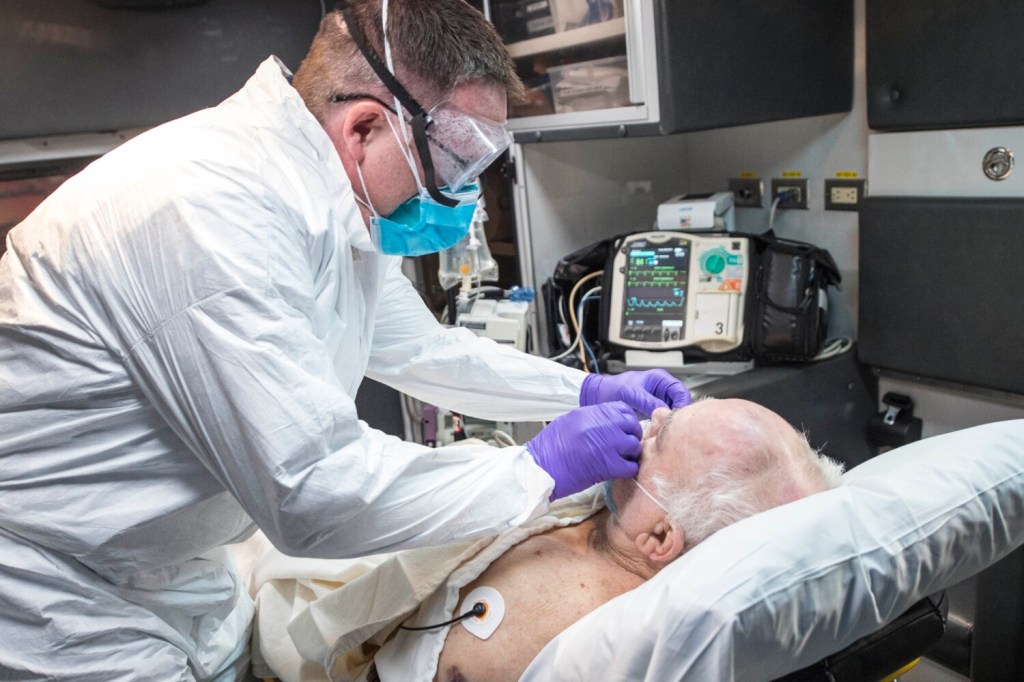The tone sounds on the scanner from dispatch. One long tone to prepare the first responders at Delta Ambulance in Waterville for an emergency call. The crew room quiets. Every ear is listening for one of three designations on the call. U-21 positive, U-21 negative or U-21 inconclusive.
The U-21 call designation alerts first responders to the confirmation or likelihood that a patient is infected with the coronavirus.
The second tone rings out. U-21 inconclusive. A tough spot for the medics.
The call is for a man found unresponsive and bleeding on the side of the street with no further information on U-21 status. It’s a predicament for how the medics approach a situation that could be a positive victim.
The pandemic has created a shortage of critical personal protective equipment, or PPE, especially for those on the front lines like paramedics and EMTs whose sole purpose is patient care and treatment. “We do this job because we care. We want to help,” said Nathaniel Lombardi, an advanced emergency medical technician with Delta.

Damian Brockway, left, a paramedic with Delta Ambulance, Nathaniel Lombardi, center, advanced EMT, and a Winslow firefighter respond to a call Tuesday in Winslow. Morning Sentinel photo by Michael G. Seamans
The first responders are a patient’s initial point of contact for treatment within the health care system, and their jobs require a high level of expertise and training, especially in central Maine, where Delta Ambulance serves 29 different communities and the paramedics have to be prepared for anything.
As the coronavirus has intensified, it’s highlighted the need for the critical care they provide.
When the U-21 inconclusive call comes in, the crew turns with a slight nervous chuckle to an action plan.
“We need to work fast,” Lombardi said.
“We need to work smart,” said Damian Brockway, who has worked as a paramedic for 23 years and serves as the other half of Lombardi’s ambulance team.
Reality lies somewhere in between those two responses these days. Safety is paramount. Infection by contamination from a patient would be devastating. “Let’s say in my 23 years I saved 20 people,” said Brockway, 42. “If I get infected and don’t know it, I could kill 40. That’s what’s at stake.”
As of Friday, health care workers accounted for 25% of all confirmed cases in the state, though that number could be skewed because they are more likely to be tested, according to the Maine Center for Disease Control & Prevention.

Nathaniel Lombardi, an advanced EMT, left, and Damian Brockway, a paramedic, both with Delta Ambulance, don their PPE April 19 as they prepare to enter a home on an emergency call in Waterville. Morning Sentinel photo by Michael G. Seamans
These days any number of symptoms can trigger a U-21 positive. Fever, chills, difficulty breathing or chest pain call for a full PPE response. “The symptoms vary from chest pains to GI issues. There’s a myriad of symptoms to look out for,” Brockway said. “When I show up to a patient’s home in this suit, I tell them, ‘It’s for your safety as much as it is for mine.’”
He jokes that his job wasn’t up to him. It’s a family calling. His father is also in the field and his wife is a paramedic as well. They met at Delta, where she also worked for six years before taking an EMS job at Redington-Fairview General Hospital in Skowhegan. Even with a degree in art, he found his way into an ambulance. “I love my job. There is nothing I’d rather be doing,” he said.
Lombardi, 24, a graduate of the College of the Holy Cross who has his sights set on medical school, is on the same page. The pair have a fun and relaxed relationship that suits the stresses of the job. Lombardi has questions and Brockway usually has the answer.
“We’re not necessarily worried about ourselves,” Lombardi said. “We’re worried about going home, bringing it back to family and other people, and then all of the nursing homes we go into and people at high-risk. ”
The medics take the utmost precaution with each ambulance. Each call requires the use of an N95 mask, of which there have been shortages nationally, and gloves. According to Phil Smith, purchasing manager for Delta, supplies are sufficient for the time being, but they’re constantly on the look-out for more masks and protective gowns.
Once on scene, one paramedic or AEMT will assess the patient from 6 feet away to gather more information. Do they have a fever? Are there any symptoms of coronavirus? If yes, full PPE is required.
The ritual includes climbing into a Tyvek suit, putting on three sets of gloves, eye wear and sometimes a face shield. This can happen up to five times a day. With eight ambulances staffed by two people each, that adds up to a lot of PPE each day: 80 suits and shields and 240 pairs of gloves for one day.

Nathaniel Lombardi, an advanced EMT at Delta Ambulance, decontaminates the ambulance Tuesday after a call in Waterville. This procedure takes place after every single call. A thorough washing of every nook and cranny on the emergency vehicle is a priority for all crews. Morning Sentinel photo by Michael G. Seamans
A newly reconfigured tiered PPE distribution system from the state of Maine dictates how much PPE different places get. Tier 1 includes hospitals, which receive 20%. Tier 2 is congregant living facilities such as long-term care facilities and nursing homes, which receive 60%. Tier 3 includes EMS, police and fire departments, which receive the remaining 20%.
Often times that means entities such as Delta get small amounts and are forced to turn to the open market to purchase life-saving PPE where costs have been driven up by high demand.
When the crew arrives at the scene with the U-21 inconclusive patient, an initial evaluation shows they are not positive for COVID-19 and the patient declines transport to the hospital. Still, the paramedics are trained to operate under the assumption every patient could have the virus, and they always respond wearing at least some PPE.
Most calls get the U-21 positive designation because of the wide range of symptoms that are present with coronavirus, but the pandemic has slowed the call load. “The calls are fewer, but much more acute care is needed on the calls we get now,” Brockway said.
The common belief among the frontline workers is the best defense as a community at this time is to stay home and practice social distancing when out of the home.

Chris Mitchell, a paramedic and supervisor for Delta Ambulance, dons his protective suit April 17 as he prepares to enter a home during an emergency call in Waterville. Morning Sentinel photo by Michael G. Seamans
Chris Mitchell, a paramedic and supervisor at Delta Ambulance, said he’s worried about a surge. “We’ve all prepared for it as best we can, but if we can avoid it, that’s the best plan,” he said.
“Please understand that our cases and hospitalizations are low because of the measures we’ve taken so far,” Mitchell said. “We can’t take that for granted. This isn’t the flu or the common cold. These patients demand resources that influenza patients don’t. When you disregard the social distancing recommendations or act as though this is all an overreaction, it becomes personal. It puts me at risk. It puts my family at risk. It puts my co-workers at risk.
“It increases the chance one of us will get exposed and bring this home to our families. If you sincerely want to thank us — paramedics, EMTs, firefighters, doctors, nurses, cleaning staff — the people who will do everything they can to help you in an emergency, then please be smart when you go out. Please socially distance. Please don’t cause the surge that you think will never come.”
Send questions/comments to the editors.





Comments are no longer available on this story